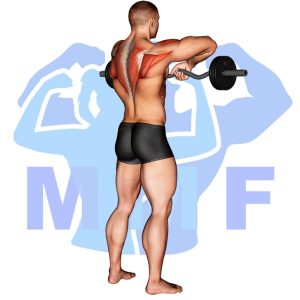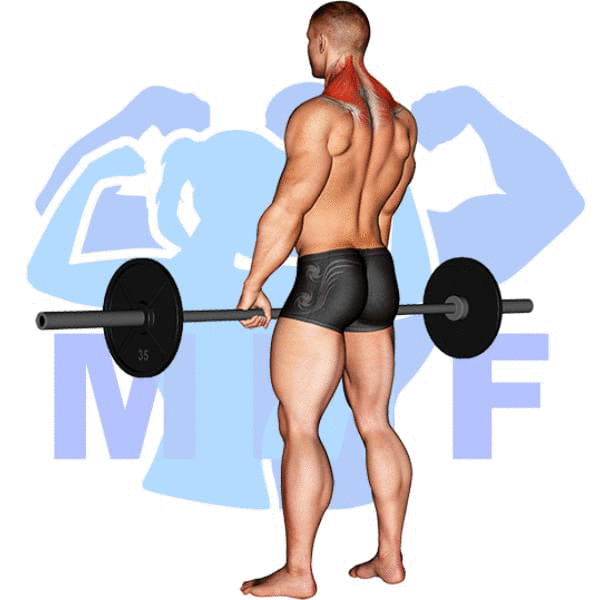Are you struggling to build strong and defined shoulders despite your efforts in the gym? Does the dumbbell full can lateral raise feel impossible for you to perform with proper form? You are not alone. Many fitness enthusiasts struggle with this exercise, but the good news is that there is a common cause for this issue. Lack of proper shoulder activation and mobility can make this exercise feel challenging. In this blog post, we will dive into the right technique to execute a dumbbell full can lateral raise, the common mistakes to avoid, and the benefits of adding it to your shoulder workout routine. With these tips and tricks, you’ll be on your way to building stronger and well-defined shoulders in no time.
Dumbbell Full Can Lateral Raise Summary
- Primary Muscles: Deltoid – Lateral
- Secondary Muscles: Deltoid – Anterior, Serratus Anterior, Supraspinatus, Trapezius – Lower, and Trapezius – Middle
- Equipment: Dumbbells
- Mechanics Type: Isolation
- Force: Push
- Utility: Auxiliary

Dumbbell Full Can Lateral Raise Instructions
- First ensure that your shoulder are warmed up, then you should pick out your dumbbells.
- Now, while standing or sitting hold the dumbbells at your side palms facing forward, you will maintain your palms forward for the entire movement.
- Then, raise the dumbbells to your side making a cross.
- Finally, after a pause at the top, lower the dumbbells back to the starting position.
- Continue to repeat to get your ideal amount of reps.
Video Tutorial
Dumbbell Full Can Lateral Raise Muscles
Target (Agonist)
Synergists
Dynamic Stabilizers
- None
Stabilizers
- Levator Scapulae
- Trapezius – Upper
- Wrist Extensors
Antagonist Stabilizers
- None

Benefits of Dumbbell Full Can Lateral Raise
The Dumbbell Full Can Lateral Raise is an excellent exercise for strengthening the lateral deltoid muscle, which is responsible for shoulder abduction. This exercise helps to develop strong and well-defined shoulders and can also be used to improve posture. It is also a great way to build muscular endurance, as it requires the deltoid to contract for a sustained period of time. Additionally, by using the full can lateral raise, you can target the medial deltoid more effectively, which can help to improve shoulder stability and coordination.
Tips for Performing Dumbbell Full Can Lateral Raise
For you to have the best muscle development, you will want to focus on these uncomplicated tips. Most Importantly, whenever you wish to avoid getting injuries, you ought stick to these tips.
- Finding A Rest Duration That Should Be Small, Yet You Can Continue To Finish The Full Set. Whenever your rest is to short you could possibly be unable to finish your entire set, if it is way too prolonged you can be simply being inefficient.
- Lift To Close To Failing For You To Raise The Teardown Of Your Muscles. Be sure to have set up effective safety precautions whenever you’re lifting to near failure.
- Do your primary compound movements at the beginning of your work out, and then perform isolation exercises to target distinct muscle groups at the end. You need the maximum functionality of your individual muscles any time you accomplish coumpound movements including, bench, deadlift, and squats. After that you need to focus on the muscle groups of which you found were weak for those movements, or areas that couldn’t get worked because of the type of compound lift you executed.
- Perform the Correct Amount Of Sets Utilizing Rest. Your target to begin with might be to do 3 sets to near fatigue. In reality, you can build up to 5 sets. If your muscles aren’t exhausted at the ending of 3 – 5 something should change. First, you can increase the resistance to make each rep more difficult. Next you can cut down on the rest time between your sets.
Benefits and Tips Video
Frequent Mistakes To Avoid
You will want to stop these regular errors to support good technique and muscle growth. Additionally, when you avoid these errors you will lessen the odds of having injuries.
- You Must Not By Pass A Warmup. getting the blood flowing to your Muscle tissue is the Fastest way to prevent personal injury.
- You’ll Do Better To Not Speed Through Your Exercise. Every time you hurry your workout you more likely to have poor form and accidents.
- Don’t Relax Your Stomach. Keeping your abs tight to protect your spinal column by maintaining your internal pressure.
Find More Dumbbell Exercises Here
Variations and Complementary Exercises
The Dumbbell Full Can Lateral Raise is a great exercise for strengthening your shoulders and stabilizing your core. If you’re looking for alternatives or variations to this exercise, here are some exercises you can use to get a similar workout:
Dumbbell Iron Cross

The Dumbbell Iron Cross is a great complement or alternative to the Dumbbell Full Can Lateral Raise. It focuses on the same muscle group, but it works them in a different way. The Dumbbell Iron Cross is an isometric exercise that requires you to hold the dumbbells in a crossed position and hold for an extended period of time. This exercise will help build strength, stability, and endurance in the shoulders, while also engaging the core and other stabilizing muscles. It is a great option for those who are looking to mix up their workout routine and challenge themselves with something new.
Dumbbell Lateral Raise

The Dumbbell Lateral Raise is a great complementary or alternative exercise to the Dumbbell Full Can Lateral Raise. This exercise is performed by standing with your feet shoulder width apart and holding two dumbbells at your side. You will then raise your arms out to the side until they are parallel with the ground. This exercise primarily works the shoulder muscles and can be used to target the outer portion of the deltoids. Additionally, this exercise can be used to increase shoulder stability and balance. With proper form, this exercise can be a great alternative to the Dumbbell Full Can Lateral Raise and can help you get the most out of your workout.
Dumbbell Upright Row

The Dumbbell Upright Row is a great alternative or complementary exercise for the Dumbbell Full Can Lateral Raise. It is performed by standing up straight and holding a pair of dumbbells in front of your body with your palms facing your thighs. Using an upright rowing motion, you lift the dumbbells up towards your chest, squeezing your shoulder blades together. This exercise targets the same muscles as the Dumbbell Full Can Lateral Raise, but it also engages your traps and upper back muscles for added strength and stability.
Check Out These Top Dumbbell Exercises
EZ Bar Upright Row

The EZ Bar Upright Row is an effective exercise that can be used as either a complementary or alternative exercise to the Dumbbell Full Can Lateral Raise. This exercise works the same muscles as the Dumbbell Full Can Lateral Raise, but with a different motion and grip. The EZ Bar Upright Row requires you to use an overhand grip on the bar, while keeping your elbows close to your body as you lift it up to chest level. This exercise targets the shoulders and upper back muscles. It is an excellent alternative for those who cannot do the Dumbbell Full Can Lateral Raise due to injury or any other limitation.
Incline Dumbbell Front Raise

The Incline Dumbbell Front Raise is a great alternative or complementary exercise to the Dumbbell Full Can Lateral Raise. This exercise works the front deltoids, anterior deltoids and upper chest. It is performed by lying on an incline bench with a dumbbell in each hand. The arms are then raised to shoulder level in front of the body in a controlled manner. This exercise is especially beneficial for those who have difficulty performing the full can lateral raise due to shoulder pain or limited range of motion.
Incline Dumbbell Lateral Raise

The incline dumbbell lateral raise is an excellent complementary exercise for the dumbbell full can lateral raise. This exercise works the same muscles as the full can lateral raise, but from a different angle. With the incline dumbbell lateral raise, you will be able to target the medial head of your shoulder muscles in addition to the lateral head. Additionally, the incline dumbbell lateral raise helps you to build greater shoulder stability and control by allowing you to perform the exercise on a steeper incline. This will help you to develop more strength and control through the entire range of motion.
Find More Shoulders Exercises Here
Opposing Complementary Exercises
To complement this exercise and ensure a balanced workout, it is important to use opposing muscle groups. Below are a few exercises that will help to work the opposite muscle groups and provide a balanced workout.
Barbell Wide Bench Press

The Barbell Wide Bench Press is an excellent exercise to pair with the Dumbbell Full Can Lateral Raise. The Barbell Wide Bench Press works the chest and front deltoids, while the Dumbbell Full Can Lateral Raise works the rear deltoids. By combining these two exercises, you can work both muscle groups in a complementary fashion. The Barbell Wide Bench Press will help to strengthen the chest and front deltoids, while the Dumbbell Full Can Lateral Raise will help to strengthen the rear deltoids. This combination will ensure that all of your shoulder muscles are equally developed, helping you to achieve optimal shoulder health.
Dumbbell Bench Press

The Dumbbell Bench Press is an excellent exercise to build strength and stability in the chest and arms. It is a great complement to the Dumbbell Full Can Lateral Raise, as it works the opposing muscle group. The Dumbbell Bench Press focuses on the chest muscles and triceps, while the Dumbbell Full Can Lateral Raise targets the shoulders and lateral deltoids. Both exercises help to build a strong upper body and promote muscular balance. Working both exercises into a regular workout routine can help to maximize your results and ensure balanced muscle development.
Cable Chest Press

The cable chest press is an effective exercise that is complementary to the dumbbell full can lateral raise. This exercise is excellent for targeting the chest muscles as it works to increase strength and muscle mass. The cable chest press also works to oppose the motion of the dumbbell full can lateral raise, which targets the shoulder muscles, by engaging the opposing muscle groups of the chest and upper back. This helps create a balanced workout that helps improve overall strength and stability.
Transform Your Lateral Raises with Dumbbell Full Can
If you’re someone who incorporates lateral raises into your upper body routine, you’ll want to take note of the dumbbell full can lateral raise. This variation will help you target your deltoids from a different angle while increasing your range of motion. By holding the dumbbells in a unique way, you’ll also be engaging your rotator cuffs, which can help prevent injuries. Don’t be afraid to switch up your exercises and try new variations to challenge your muscles and achieve your fitness goals.
References: Wikipedia | ExRx.net | PubMed.gov | Comprehensive List of Shoulders Dumbbell Exercises




